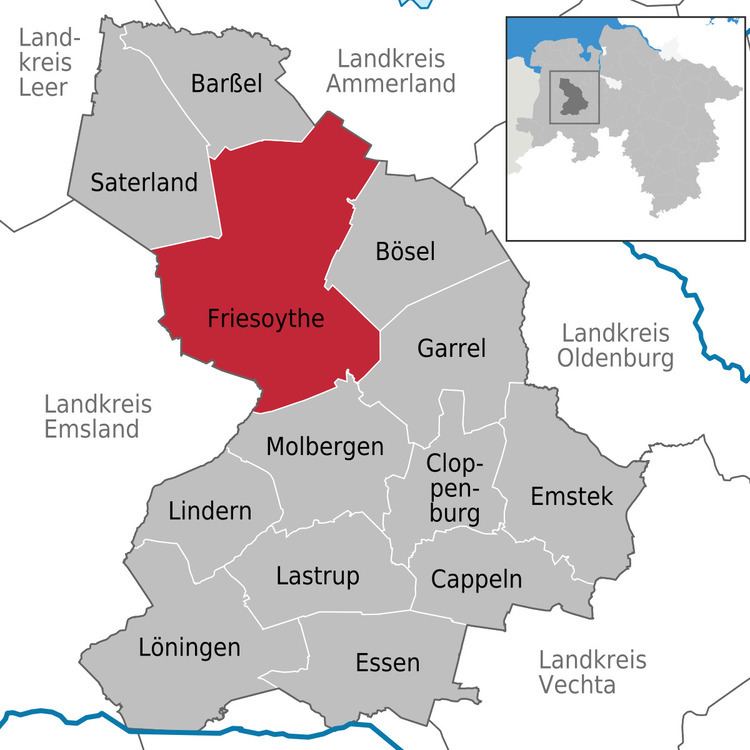Time zone CET/CEST (UTC+1/+2) Area 247.1 km² Local time Friday 8:41 PM | Elevation 6 m (20 ft) Postal codes 26169 Population 20,599 (31 Dec 2008) Postal code 26169 | |
 | ||
Weather 6°C, Wind SW at 26 km/h, 83% Humidity Points of interest Tier‑ und Freizeitpark Thüle Gm, Postgeschichtliches Museum Friesoythe, Der Schafstall | ||
Friesoythe, in Saterland Frisian language Ait or Äit, is a town in the district of Cloppenburg, in Lower Saxony, Germany. It is situated on the river Soeste, approximately 25 km northwest of Cloppenburg, and 30 km southwest of Oldenburg.
Contents
- Map of Friesoythe Germany
- History
- Second World War
- 21st century
- Sons and daughters of the city
- People related to Friesoythe
- References
Map of Friesoythe, Germany
History
Friesoythe shares a diverse culture in Lower Saxony history. Many cultural influences of German, Anglo-Saxon, Dutch, East Frisian, Danish and Swedish culture are noticeable in the town and citizens. The town has a large following of Roman Catholicism and small percentages of Calvinism and Lutheranism. It was part of the Prussian empire and also under rule to the French Empire in the 18th century.
Second World War
In April 1945, the town of Friesoythe felt the full force of an attack by the 4th Canadian (Armoured) Division, under General Christopher Vokes. Most of the town's population of 4,000 moved out to the surrounding countryside on about April 11–12, 1945.
The town was defended by some 200 paratroopers of Battalion Raabe of the 7th German Parachute Division. These paratroopers repelled the first attack by the Lake Superior Regiment (Motor) on April 13. The Lake Superior Regiment suffered two dead and nineteen wounded. German casualties are not known.
Vokes ordered the resumption of the attack the next day by The Argyll and Sutherland Highlanders of Canada (Princess Louise's) commanded by Lt. Col. Frederick E. Wigle. The attack went well, with the Argylls securing the town by 10:30 hours. However, at 08:30 a small number of Germans caught Wigle's tactical headquarters by surprise; resulting in the death of Wigle and several other soldiers. Lieutenant Alan Earp also survived a direct shot through the head.
Vokes determined on an immediate reprisal. "A first-rate officer of mine, for whom I had a special regard and affection, and in whom I had a particular professional interest because of his talent for command, was killed. Not merely killed, it was reported to me, but sniped in the back". Vokes then announced his draconian decision. “I summoned my GSO1 . . ‘Mac,’ I roared at him, ‘I’m going to raze that goddam town.’”
Individual units and soldiers of the Argylls had spontaneously begun the arson of Friesoythe by way of revenge for the death of their colonel, but after Vokes issued his direct order, the town was systematically set on fire by means of flamethrowers mounted on Wasp Carriers. The destruction was massive. According to German estimates, 85% to 90% of the town was destroyed in the course of this reprisal, making it one of the most devastated towns in all of Germany at the time.
21st century
Friesoythe has grown from a village to a small city and shares old traditional and modern style build buildings of German architecture, Bauhaus, Victorian style, Renaissance and Barok style. Large multinational companies are settled giving the city a modern appearance and lively feeling. Hospital, schooling, bus and train service, health service are all available in the city centre. The city has good communication and infrastructure and many American Germans and Polish, Russians integrated.
